RNA helicase p68 (DDX5) regulates tau exon 10 splicing by modulating a stem-loop structure at the 5' splice site
- PMID: 21343338
- PMCID: PMC3133221
- DOI: 10.1128/MCB.01149-10
RNA helicase p68 (DDX5) regulates tau exon 10 splicing by modulating a stem-loop structure at the 5' splice site
Abstract
Regulation of tau exon 10 splicing plays an important role in tauopathy. One of the cis elements regulating tau alternative splicing is a stem-loop structure at the 5' splice site of tau exon 10. The RNA helicase(s) modulating this stem-loop structure was unknown. We searched for splicing regulators interacting with this stem-loop region using an RNA affinity pulldown-coupled mass spectrometry approach and identified DDX5/RNA helicase p68 as an activator of tau exon 10 splicing. The activity of p68 in stimulating tau exon 10 inclusion is dependent on RBM4, an intronic splicing activator. RNase H cleavage and U1 protection assays suggest that p68 promotes conformational change of the stem-loop structure, thereby increasing the access of U1snRNP to the 5' splice site of tau exon 10. This study reports the first RNA helicase interacting with a stem-loop structure at the splice site and regulating alternative splicing in a helicase-dependent manner. Our work uncovers a previously unknown function of p68 in regulating tau exon 10 splicing. Furthermore, our experiments reveal functional interaction between two splicing activators for tau exon 10, p68 binding at the stem-loop region and RBM4 interacting with the intronic splicing enhancer region.
Figures
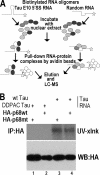
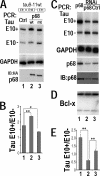

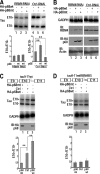
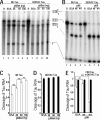
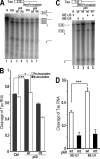
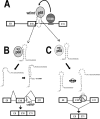
Similar articles
-
PSF suppresses tau exon 10 inclusion by interacting with a stem-loop structure downstream of exon 10.J Mol Neurosci. 2011 Nov;45(3):453-66. doi: 10.1007/s12031-011-9634-z. Epub 2011 Sep 1. J Mol Neurosci. 2011. PMID: 21881826 Free PMC article.
-
RBM4 interacts with an intronic element and stimulates tau exon 10 inclusion.J Biol Chem. 2006 Aug 25;281(34):24479-88. doi: 10.1074/jbc.M603971200. Epub 2006 Jun 15. J Biol Chem. 2006. PMID: 16777844 Free PMC article.
-
Regulation of alternative splicing by the ATP-dependent DEAD-box RNA helicase p72.Mol Cell Biol. 2002 Aug;22(16):5698-707. doi: 10.1128/MCB.22.16.5698-5707.2002. Mol Cell Biol. 2002. PMID: 12138182 Free PMC article.
-
The role of DEAD-box RNA helicase p68 (DDX5) in the development and treatment of breast cancer.J Cell Physiol. 2019 May;234(5):5478-5487. doi: 10.1002/jcp.26912. Epub 2018 Nov 11. J Cell Physiol. 2019. PMID: 30417346 Review.
-
P68 RNA helicase as a molecular target for cancer therapy.J Exp Clin Cancer Res. 2014 Aug 24;33(1):64. doi: 10.1186/s13046-014-0064-y. J Exp Clin Cancer Res. 2014. PMID: 25150365 Free PMC article. Review.
Cited by
-
Cognitive neuroepigenetics: the next evolution in our understanding of the molecular mechanisms underlying learning and memory?NPJ Sci Learn. 2016;1:16014. doi: 10.1038/npjscilearn.2016.14. Epub 2016 Jul 20. NPJ Sci Learn. 2016. PMID: 27512601 Free PMC article.
-
Spliceosomal genes in the D. discoideum genome: a comparison with those in H. sapiens, D. melanogaster, A. thaliana and S. cerevisiae.Protein Cell. 2011 May;2(5):395-409. doi: 10.1007/s13238-011-1052-z. Epub 2011 Jun 12. Protein Cell. 2011. PMID: 21667333 Free PMC article.
-
Regulation of alternative splicing of tau exon 10.Neurosci Bull. 2014 Apr;30(2):367-77. doi: 10.1007/s12264-013-1411-2. Epub 2014 Mar 14. Neurosci Bull. 2014. PMID: 24627328 Free PMC article. Review.
-
The adipogenic transcriptional cofactor ZNF638 interacts with splicing regulators and influences alternative splicing.J Lipid Res. 2014 Sep;55(9):1886-96. doi: 10.1194/jlr.M047555. Epub 2014 Jul 14. J Lipid Res. 2014. PMID: 25024404 Free PMC article.
-
Alternative splicing of TAF6: downstream transcriptome impacts and upstream RNA splice control elements.PLoS One. 2014 Jul 15;9(7):e102399. doi: 10.1371/journal.pone.0102399. eCollection 2014. PLoS One. 2014. PMID: 25025302 Free PMC article.
References
-
- Andreadis A. 2005. Tau gene alternative splicing: expression patterns, regulation and modulation of function in normal brain and neurodegenerative diseases. Biochim. Biophys. Acta 1739:91–103 - PubMed
-
- Andreadis A. 2006. Misregulation of tau alternative splicing in neurodegeneration and dementia. Prog. Mol. Subcell. Biol. 44:89–107 - PubMed
-
- Andreadis A., Brown W. M., Kosik K. S. 1992. Structure and novel exons of the human tau gene. Biochemistry 31:10626–10633 - PubMed
-
- Avila J., Lim F., Moreno F., Belmonte C., Cuello A. C. 2002. Tau function and dysfunction in neurons: its role in neurodegenerative disorders. Mol. Neurobiol. 25:213–231 - PubMed
Publication types
MeSH terms
Substances
Grants and funding
LinkOut - more resources
Full Text Sources
Other Literature Sources
Molecular Biology Databases
